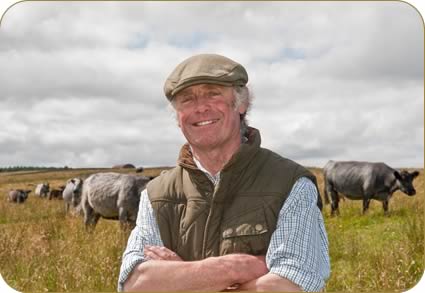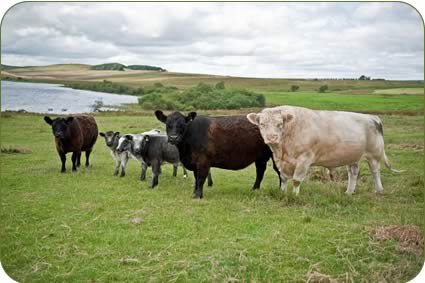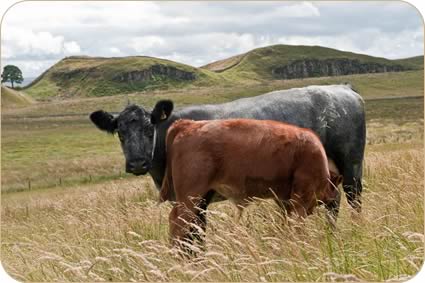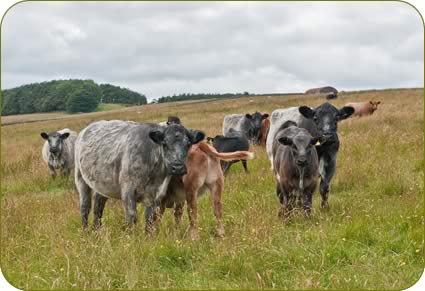Jennifer MacKenzie is an agricultural photo journalist with almost 30 year's experience. Operating from her base in Cumbria, Jennifer undertakes mainly industry-related freelance writing and photography.
Blue Greys On The Wall
With no winter housing and the many constraints with farming on a World Heritage Site - Hadrian’s Wall - the Pattinsons continue the family tradition in the cattle they breed.
National Trust tenants John and Pamela Pattinson and their son Jonjo farm 1,300 severely disadvantaged, all-grass acres at Hotbank which straddle the Roman Wall near Bardon Mill.
 |
John Pattinson |
They farm in compliance with many organisations on the severely disadvantaged land, including the Northumberland National Park, English Heritage and Natural England.
Galloways have been crossed with the Whitebred Shorthorn to produce the Blue Grey since John’s father, Joseph first moved to Hotbank in 1934 and while other breeds have been tried, the traditional cattle are found to be the ideal for the farm, the environment and the family.
 |
Whitebred Shorthorn Bull, Galloway Cows and Blue Grey Calves |
While Jonjo works at home, the rest of the family also helps out
on the farm - Alice is agricultural manager for beef and dairy at Sainsburys,
Louise is a pharmacist, Gillian is a land agent at Hexham and Northern
Rural and Robert is a vet.
In fact, Joseph was a member of the committee which founded the Whitebred Shorthorn society in the 1960s and John has been involved with the Blue Grey Cattle Group which has recently been set up to highlight the attributes of the hardy cross.
The herd comprises 90 cows, half of which are pure Galloways and the remainder their Blue Grey daughters along with a handful of Whitebred Shorthorns to breed bulls to cross with the Galloway.
A dozen to 15 of the best Galloway females are put back to the Galloway bull for herd replacements and the rest is crossed with the Whitebred Shorthorn.
Around 15 Blue Grey females are sold each year with the rest kept for the herd. These are crossed with Limousin and Aberdeen Angus bulls and the calves are sold from six months to a year old.
In 2013, the heifers made a top price of £1,250 a head for two year olds while 16 month old heifers brought £1,150 a head in a very buoyant trade for the increasingly popular Blue Grey.
“There is definitely a resurging interest in the Blue Grey, both as a hardy suckler cow and for bullocks with demand for traditionally-reared, quality beef,” said John. “The Whitebred Shorthorn bull and Galloway cow are tailor made for each other.”
 |
Blue Grey Cow and Limousin X Calf |
The bullocks, which are sold at 18 months old either at Longtown or the Hexham traditional breeds sale both in the autumn, attract regular buyers - one finisher from south west Scotland has bought them from John for 30 years and a more recent purchaser is Tebay Services.
John tried using continental bulls on the Galloways but he says it was a lot of hard work with often difficult calvings and they only lasted half as long as the Blue Grey cow.
“They were bigger cows which ate more and caused more damage to the rough grazing, an important environmental feature. Our land is in Higher Level Stewardship and we have two SSSIs, Roman Wall Escarpments and Roman Wall Loughs.”
The Pattinsons took part in the Northumberland National Park Drovers Project from 2003-2005 and the first site to be grazed under the agreement was Cragend on Hotbank Farm.
The objective was to use Galloway and Blue Grey cattle to reduce the dominance of Purple Moor Grass (Molinia caerulea) from June to September in order to open up the vegetation sward to allow greater species diversity and to encourage heather regeneration.
“We were also losing that hybrid vigour with the continental crosses. While we got a good price for the calf, it took a lot of hard work to get there.
“The advantages of the Blue Grey, the Galloway and the Whitebred are that they can be out wintered outside with very little to eat,” he said.
They are hardy, easily kept and long-lived. Calving is unassisted and vet bills are at a minimum although the Blue Grey heifers are tested for BVD, Johnes and IBR before being sold.
“The Blue Grey is attracting interest partly because of its eatability - you can’t beat the meat for taste and tenderness. They are reared slowly and naturally on hill pastures at Hotbank with no artificial fertilisers, not even on our land for hay - only farm yard manure,” John added.
 |
Blue Grey Cows and Limousin X Calves |
Last year, Blue Grey bullocks were making up to £900 a head at 18 months old when sold through the ring at Longtown and Hexham. All the calves are sold off grass.
The Whitebred Shorthorn passes on its trait of extra milkiness which, combined with the hardiness of the Galloway, produces an animal with hybrid vigour which is very low maintenance, says John.
“The Blue Greys are fertile and prolific producing a calf a year - in fact, one we sold lived until she was 22 years old and produced a calf each year!”
Most of the herd calves in the spring with around a dozen calving in the autumn. The area has high rainfall yet all the cattle have to be out wintered.
The spring calvers are supplemented with round bale haylage. The autumn calvers also receive some sugar beet pulp.
The Pattinsons also run 500 Hexham type Blackface ewes, half of which are bred pure and the remainder crossed with the Bluefaced Leicester. A flock of 20 Bluefaced Leicester ewes is kept to breed rams some of which are sold at Hexham. Mule ewe lambs are sold at Hexham Mart.

